Table of Contents[Hide][Show]
What are healthy carbohydrates for people with type 2 diabetes and prediabetes?
What are you supposed to be eating? Especially to keep your blood sugar levels in a healthy range?
These are common questions that can be confusing so let’s get straight to business and dig in and answer those questions now.
Let’s walk through some of the individual aspects of carbs and then we’ll wrap it up into something simple and practical that you can apply to your everyday life, okay?
RANDOM FACT
The body has essential needs for amino acids (protein) and fats but there are no essential carbohydrates required!
That’s a crazy fact, right!
Of course that doesn’t mean we do live without carbohydrates, because we love carbohydrates of all kinds, a little too much most of the time.
And, carbohydrates as a food group are one of the healthiest for us – they provide vitamins, minerals, phytochemicals, and compounds that are beneficial for our health. And they also provide fiber, too.
But… not all carbohydrates are created equal. And when it comes to maintaining healthy blood sugar levels, the type of carbs you choose is critical.
Thankfully though, there are healthy carbohydrates you can eat and keep blood sugar in a healthy range.
Too Many Carbs Is The Issue
The average person consumes way too many carbohydrate foods – around 800 calories worth per day, according to one study comparing 158 countries!
The thing to understand, is that as a person with diabetes or prediabetes, carbohydrates are the type of food you need to get a good handle on. Why?
Because the amount of carbs you eat influences your blood sugar and A1C more than any other nutrient!!
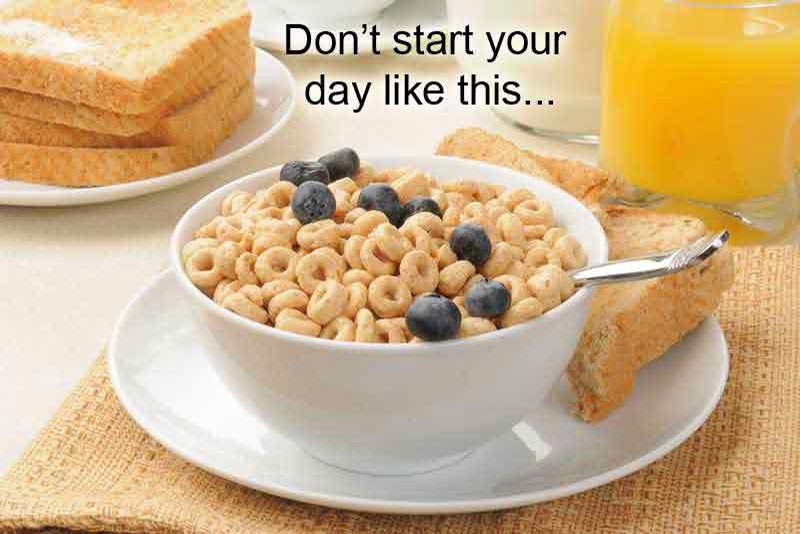
Let’s take a look at a typical day on a Western diet plan:
Breakfast: Toast and cereals with a glass of orange juice – carbs.
Morning tea: 1 small blueberry muffin – carbs.
Lunch: A ham salad sandwich and a coke – carbs.
Afternoon tea: A packet of salt and vinegar chips and a choc chip cookie – carbs.
Dinner: Spaghetti pasta with a jar of sugar-filled bolognese sauce – carbs.
Dessert: 1/2 cup chocolate ice cream – carbs!!
Nutrition Breakdown Of The Average Menu

As you can see, carbohydrates total to around 337 g for just one day eating such a menu. Even just one day like this is problematic, let alone eating that many carbs day in and day out.
It also provides very little in the way of nutritional quality. Studies indicate that while the average person tends to eat a lot these days we have rising levels of nutritional deficiencies, even in Western societies where food is ample!
And in terms of carbohydrates and diabetes, it’s been an interesting history. For many, many years, people with diabetes or prediabetes have been told to eat more carbohydrates and less protein and fat – that’s been a very common recommendation for decades. Unfortunately, this is very problematic because as a diabetic you are essentially carbohydrate intolerant. Meaning, your body has lost the capacity to deal with glucose in the blood effectively.
While every person does have a different level of carb intolerance, a lower carb diet has proven the best method for lowering blood sugar and A1c levels.
How Carbs Affect Your Body
Let’s just get back to basics for a second and focus on how carbs influence your body.
The written explanation
You eat carbohydrates -> Your body processes this and as a natural response your blood glucose rises -> Your pancreas releases the hormone insulin to lower your blood glucose -> As a diabetic you have an inability to uptake glucose into the cell effectively, which leaves your blood glucose high (this is called insulin resistance) -> More insulin in the bloodstream increases insulin resistance -> Insulin is also the fat storage hormone so all the excess glucose in your blood gets pushed into fat cells -> This increases triglycerides and cholesterol levels and increases inflammation causing more issues. -> So it can become a bit of a repetitive cycle.
The video explanation
Here’s a simple video that shows how the carbohydrates we eat triggers insulin.
The affect of carbohydrate intake on blood glucose occurs whether we have diabetes, prediabetes or not. Carbohydrates are carbohydrates. This is the natural physiological response of the body. But, as a person with diabetes or prediabetes, your ability to deal with the carbs is impaired.
So how can you lower and control this high blood glucose?
You have to change gears on the type of carbohydrates you eat!
Carbohydrate Basics
When you think of carbohydrates, it probably brings to mind things like potatoes, rice, pasta and bread. And more than likely, many things on this common list of carb sources include processed and refined foods such as white bread, white pasta, and white rice, which are high energy carbohydrate foods that will spike your blood sugar much quicker than a complex carb.
Simple and Complex Carbs
Simple sugars/carbs – refined white sugars, white flours, white breads, white pastas – these uptake into the bloodstream with little digestive processing needed, and therefore, they tend to spike blood sugar faster and higher.
Complex sugars/carbs – have to get processed and converted to glucose and take longer to enter the bloodstream. Complex carbohydrates are often higher in dietary fiber, and the fiber is there to slow digestion and absorption of glucose so that blood sugar raises slower and hormone levels stay more stable.
Here’s a list of some of simple and complex carbs so you can see the difference between them:
- Avoid ALL Simple Carbs
- sugar
- white sugar
- white flour
- white bread
- white pasta
- soft drinks & sodas
- energy drinks
- fruit juices
- many cereals
- many crackers
- many sauces and condiments
- processed food
- ice creams
- cakes & cookies
- pies
- fruit
- honey
Better Choices BUT there’s more to it (see below)
- whole grains
- whole grain breads
- whole grain crackers like brown rice cakes
- gluten free wholegrain pastas
- brown rice
- quinoa
- buckwheat
- vegetables – loads of them to choose from
- beans and legumes such as:
- chickpeas
- lentils
- adzuki beans
- borlotti beans
- navy beans
- wild rice
- oats
- sweet potato
It’s good to be aware of what simple and complex carbs are because if you go read other websites you will notice that the carbohydrate advice for people with diabetes, often says to include complex carbs. And it certainly is true that complex carbs are a better choice than simple carbs.
However, what you need to know is that…
All types of carbohydrates break down to glucose, period!
Even if it takes longer to digest, the glucose is still going to end up in your bloodstream!
That means even complex carbs from things like grains can be problematic because they are high in carbohydrate content. So let’s dig even deeper to find out why and what your best choices are.
Complex Carb Choices
Basically you have 4 categories of complex carbs to choose from:
- Vegetables
- Fruit
- Whole grains
- Beans and legumes
Let’s cover each one of these categories in more detail.
Eat More Veggies
Vegetables are a complex carbohydrate!

Most people don’t think of vegetables when they think of carbs.
However, vegetables are the type of carbs you really need to focus on eating more of, because they are more nutrient dense – meaning, they are full of vital vitamins, minerals, antioxidants, and other compounds that the body needs to fuel it’s optimal function.
Statistics show that only 8% of the population are eating the recommended 5 servings a day of vegetables, with 25% getting only one serve a day, and the rest…well they are not eating any veggies at all!
One serving of vegetables is equivalent to around half a cup. So 2.5 cups a day minimum is the main aim. With diabetes though, since you need to cut down on other complex high carb foods – potatoes, rice, bread, pasta – you should really be eating way more than 2.5 cups of veggies per day.
Vegetables contain so many valuable nutrients and compounds that can guard us against disease. They reduce energy density of the diet, helping you lose weight. They provide valuable fiber that helps promote healthy digestion, they help reduce sugar cravings, and they just make you feel great.
Vegetables are by far the very best form of carbohydrate for you to choose, well at least most of them are.
Types of Vegetables to Include & Avoid
AVOID
MODERATE
INCLUDE
- Potatoes
- Sweet potato
- Yams
- Plantains
- Corn
- Carrots
- Beetroot
- Parsnip
- Pumpkin
- Swede
Fruit
Fruit is a natural food source so if you were to choose something sweet you’d be far better to choose a small piece of fruit.
However, most fruit also happens to be a high source of carbohydrates. And despite commonly held assumptions that fruit juice is healthy, it’s not.
Fruit juice is a BIG NO NO!
It’s extremely high in sugar/ carbs.
Take a look at this apple verse apple juice comparison.
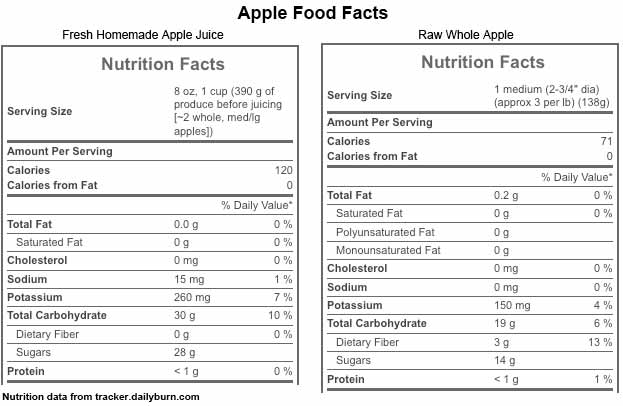
As you can see, eating the whole apple provides 19 g total carbs, 3 g fiber, 14 g sugar. Whereas, if you drink 1 cup apple juice, it sharply increases the carb and sugar count, and decreases fiber.
All and all, when it comes to fruit, the best fruits for a diabetic are berries such as strawberries, raspberries, blueberries. These are lower carb options that won’t have a great impact on blood sugar and A1c. You can have around 1/2 cup per serve. Berries make a nice dessert served with something like cottage cheese or yogurt.

Whole Grains
Now we’ve already covered all the white processed forms of grains above. Things like white rice, white pasta, white bread, white flour, and packaged foods that often contain simple carbs, and sorry to say but these all have to get the cut.
But what about whole grains?
Well, they are a complex carbohydrate and you can eat whole grains and count carbs and monitor your intake. BUT it is far, far easier to get better results if you AVOID ALL GRAINS!
Did you just say avoid all grains?
Yes.
The American Diabetes Association Standards of Medical Care in Diabetes, state that: “whole-grain consumption is not associated with improvements in glycemic control in type 2 diabetes.”
Or in other words, whole grains do not help you regulate blood sugar and A1c – that’s what the research clearly shows again and again. There is no evidence to suggest whole grains benefit blood sugar in any way, quite simply because they are a high carb food. And hopefully by now you are beginning to understand their strong influence on your numbers.
Eliminating grains, or at the very least cutting them down drastically, is initially a challenge for many people but if you REALLY want to control your blood sugar and avoid the progression of complications long term, then avoiding grains is the way to go. It also helps to un-complicate things for you, allowing you to enjoy your food more without having to worry so much about counting every single carb.
Sure, it’s an adjustment. But you certainly won’t starve.
There are plenty of things you can still eat – if you’re stuck for ideas, check out our weekly meal plans.

Pictured above are two of our low carb breads – even without grains there is plenty to eat!
Anyway, let’s just get back to the whole grain debate for just one minute.
Example
Let’s just say you want to have a couple of slices of toast for breakfast or some brown rice with dinner and you’re aiming to keep your carb count to 30 g per meal.
- Brown rice has a net carb count of 19 g per serve (1/2 cup). Now half a cup isn’t that much, and most people normally eat more than this (it’s easy to do). So you would have to measure your portion sizes AND keep a closer check on your blood sugar levels. NOTE: Total carbs minus fiber = net carbs.
- 1 slice whole grain toast has a net carb count of 12.5-15 g per serve. So if you wanted to eat 2 slices that bumps you up to 25-30 g just for just the toast, without any toppings.
What most people don’t realize is that grain based foods are very high in carbohydrates. So avoiding them, at least for the most part, cuts out a majorly big hassle for you. And helps you control blood sugar and A1C levels much easier.
Beans & Legumes
Beans and legumes include things like adzuki beans, chickpeas, brown and red lentils, lima beans, borlotti beans, broad beans, fava beans, garbanzo, lima beans, navy beans, mung beans, and so forth.
These do contain protein, but what many people do not realize is they are predominantly a carbohydrate food.
While beans and legumes are beneficial for feeding gut bacteria that support our health, you need to keep a tight limit on your portions.
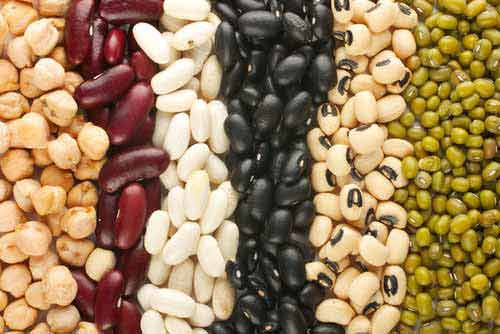
Here is the net carbs for some beans (per 1/4 cup):
- Edamame (young soy beans) – 1.75 g
- Northern beans – 6 g
- Pinto beans – 7.5 g
- Lentils – 6 g
- Navy beans – 7 g
- Black beans – 6.5 g
- Soy beans – 9 g
- Chickpeas (Garbanzo) – 10 g
- Red kidney beans – 7.5 g
If you were to follow a truly low carb diet, you would exclude beans and legumes.
But, there is research to show that the soluble fiber and resistant starch in beans and legumes provide some great health benefits. They have a low glycemic index and are considered slow carbs, so for most people, it’s okay to eat small portions of beans and legumes in moderation (1/4 cup per serve).
The soluble fiber in beans and legumes will slow down the glucose uptake but keep in mind that the carbs still end up in the bloodstream. If you want to include beans and legumes, then limit them to 1/4 cup or maximum 1/2 cup per serving and choose the lower carb options as outlined above. That’s only going to be around 6-8 g net carbs per serve, and you can still include lots of veggies and some meat for a well-rounded meal.
Resistant starch is beneficial for fostering more good gut bacteria.
Resistant starch is digested differently to other starches. It passes through the small intestine undigested – similar to soluble fiber.
It makes its way to the colon where it is then fermented by microbes that produce byproducts called short chain fatty acids – butyrate, acetate and propionate. These unique fatty acids feed healthy gut bacteria, along with playing important roles in lipid, glucose, and cholesterol metabolism.
TIP: To get the most resistant starch out of beans and legumes, it’s best to cook them and cool them, then reheat them if you wish to use them in a meal. The heating and cooling, increases the amount of resistant starch in them.
Note though, some people with diabetes will not be able to tolerate any beans or legumes. The only real way to know is to use your blood sugar monitor and assess how foods influence you.
Please pin this info to share with others – then keep reading. 🙂
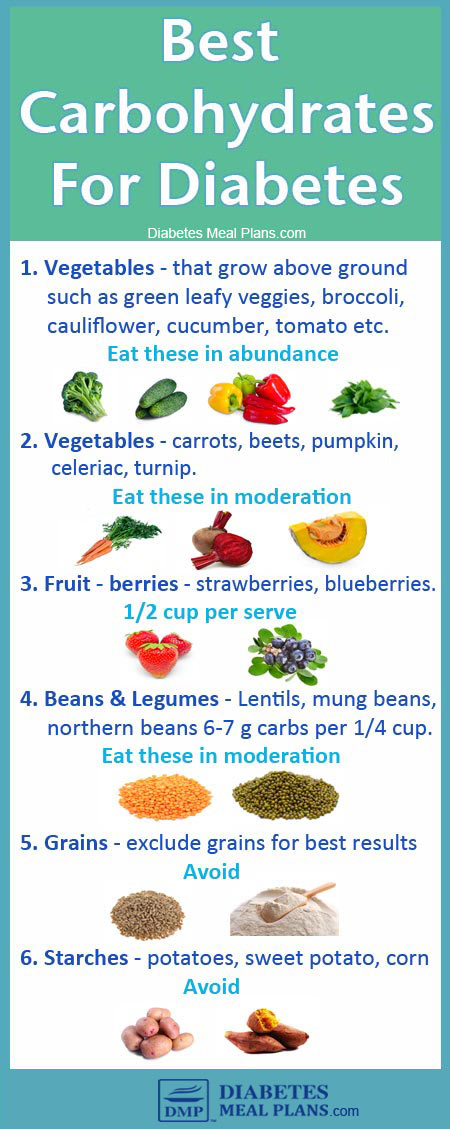
What can I eat then?
Right now you may feel like you won’t be able to eat anything. We assure you this is not true.
It can take some adjustment, but there is still plenty you can eat. That’s exactly why we created an amazing meal planning service, to help make eating a lot easier!
In any case, you probably have a few questions, like:
- What will I eat for breakfast?
- What about bread? Can I still eat bread?
- Or what’s the healthy amount of carbohydrates to eat?
Let’s give a few brief answers now…
What will I eat for breakfast?
Breakfast cereals are off the list, at least the kind you find on the supermarket shelf. Yes, even things like wheat biscuits and whole grain options, and even oatmeal in many cases, we’ve already talked about why.
When it comes to bread, there’s no doubt that it’s something that everyone loves, but we can definitely live without it, plenty of people do. Of course, there are low carb bread options, too.
And of course, if you’re motivated to make your own breads, there are loads of low carb flours you can use instead.
What are your breakfast options?
We’ve been conditioned to think we need to eat cereal for breakfast because we have this idea in our head about what breakfast foods are, we’ve just been raised like that.
But what you need to be eating for breakfast is a real wholesome meal loaded with good food. The beginning of the day is the most critical time to eat a good meal in order to sustain your energy, balance your hormones, and prevent sugar cravings and binge attacks later in the day.
The trick is to start thinking about breakfast differently.
Why not have egg muffins, make a low carb muesli, eat a chicken and vegetable soup for breakfast (yes, soup works well for breakfast!), or have some eggs and veggies – like a mixed veggie omelet.
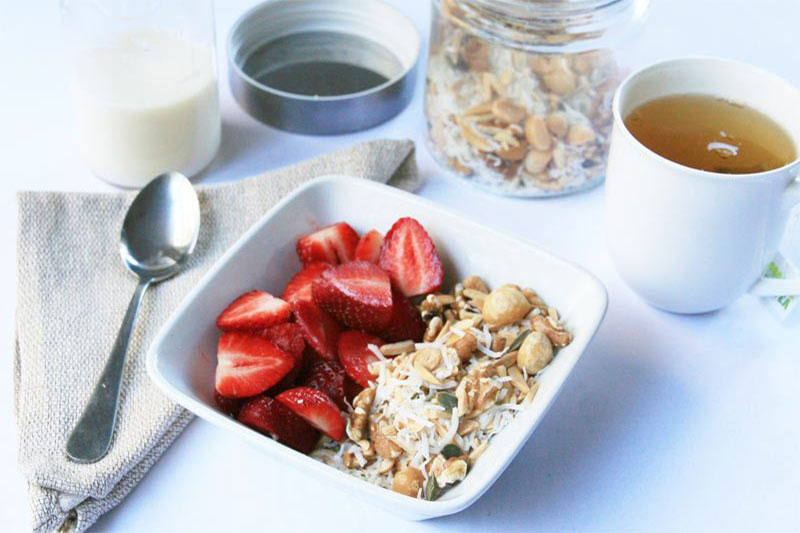
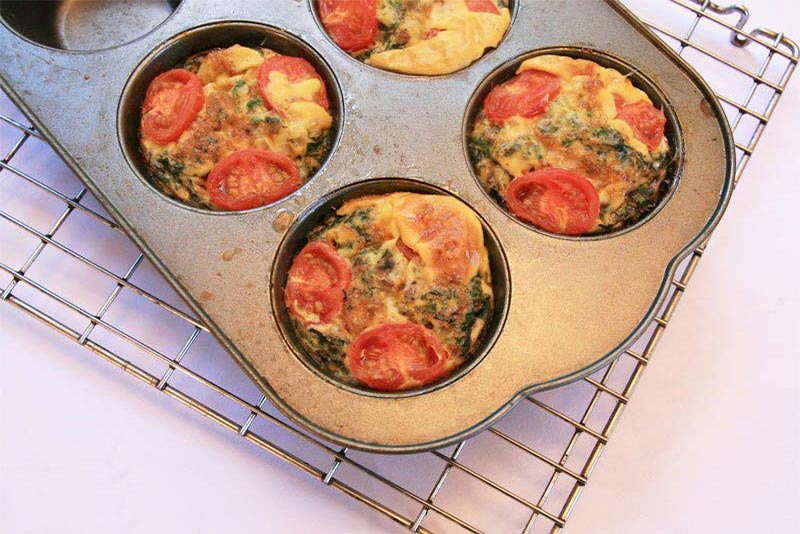
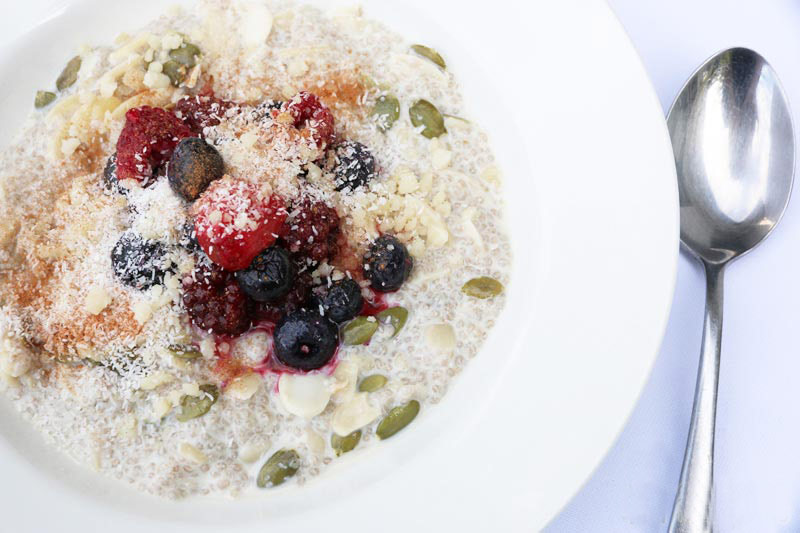
Yes, it may sound strange and takes a while to get used to, but this is really how we’re meant to be eating (eating real food!) and you’ll find it gives you a much better start to the day.
Best Source Of Healthy Carbohydrates: The Run Down
Just to clarify what you’re aiming for in choosing healthy carbohydrate sources to manage your diabetes or prediabetes.
1. Eat more vegetables
Especially vegetables that grow above the ground such as green leafy veggies, broccoli, cauliflower, cucumber, tomato and so forth.
Vegetables are your number one main priority and inclusion – mainly non-starchy vegetables. There is such a wide variety to choose from that you will never get bored. The aim is a minimum of 5 serves a day – equal to about 2.5 cups, but you should easily be able to eat more.
2. Eat moderate carb vegetables in moderation
This includes veggies like pumpkin, beets, celeriac and turnip.
3. Eat lower carb fruits
Berries such as strawberries, blackberries, blueberries, raspberries are the best options. Followed by passionfruit (1), cantaloupe/rockmelon (1/2 cup), guava (1), plum (1).
4. Limit beans and legumes
Remember beans and legumes are higher in carbs than protein so monitor your portions. Edamame (young soy beans) is the lowest carb option, followed by lentils, black beans and northern beans.
5. Exclude, or greatly limit, grain-based foods
Pasta, rice, noodles, crackers, cakes, pastries etc. This includes whole grain foods too.
6. Exclude, or greatly limit, starchy high carb vegetables
Potatoes, sweet potatoes, yams, plantain and corn.
As a rule do not displace vegetables for any other type of food, you must get those veggies for their super nutritional power!
If you stick to the above ‘rules’ for selecting healthy carbohydrates, you will find yourself having less struggles with lowering and maintaining blood sugar!
Please share this great resource around with other friends, family and colleagues who may need it.
Totally confused by everything?
Take Dr Jedha’s clinically proven T2Diet Program.
The 16-week online program will guide you step-by-step on exactly what to eat to lower blood sugar and A1c, lose weight if you need to, and reduce medication.


I have IBS, leaky gut, can’t eat much fruit or vegetables. I don’t know what to eat anymore on a diabetes diet. I cannot handle beans. I can’t eat fresh fruit. I can’t eat raw vegetables. I’m kind of at a loss. How do I get the right diet. I was told to eat whole-grain bread now I’m reading not to. I was told I could eat whole wheat bread now apparently I’m not supposed to eat that either. I’m very confused.
Hi Janet, do you know about fodmaps? We’re currently working on a detailed guide for our members that includes fodmaps for diabetes, but in the meantime you may find that info helpful. The other thing is making a list of all the foods you can eat and determining based on that what is/isn’t diabetes friendly. There will still be a wide variety of foods to eat, it’s just getting your head around which ones and into a routine.
I’m newly diagnosed with T2 diabetes. I’m about one week into this new diet/lifestyle.
I don’t eat much anyway, but my former main diet was loaded with carbs and sweets. Very bad, I know, but I figured that I was doomed to get diabetes since it runs on both sides of my family. Damned if I do, damned if I don’t.
Well, even though I tried to avoid this disease in the recent years, it didn’t matter. As I anticipated, I still got it.
Now, I’ve pretty much kicked carbs to the curb. Carbs transform into sugar which then transforms into fat.
I’m taking morning walks every day and eating much smaller portions. I’m feeling pretty good actually!
I’m adding more veggies that I like into my meals along with proteins.
I already love berries, so that’s a huge bonus for me.
The problem that I’m having is this:
I LOVE Italian food and my soul is crying that I can’t enjoy it again. Miracle Noodles are disgusting (and expensive). I heard that even veggie pasta (like Barilla) is a sham. Tri-Color rotini isn’t even good because it’s apparently only colored with tomatoes and spinach.
If I very, very sparingly eat carbs, will it hurt me? Once or twice a month wouldn’t do much harm? If the carbs are mixed with a protein or fiber food, does it still drastically spike your glucose levels? (ie: tuna salad with egg and pasta)
I can’t go through life sans Italian food. I am willing to cut back.
I gave up sweets. I don’t even miss them really.
I cannot go without pizza and spaghetti (with ground turkey). Just can’t.
If I can have them once in a long while, I can take some comfort in that.
V, you don’t have to completely live without foods you may love, as these add pleasure to our lives, which is important too. But, many people can overcome their attachment to ‘favorite’ foods too. The best way for you to assess how this will affect you is to test your levels after a pasta or pizza meal. If they are high 2-hours after your meal, you may want to rethink it.
Good info
Protein what can I eat besides beans (they do not like me) Thank You.
Are you looking for vegetarian sources of protein? If so, check out this article! Some vegetarian sources of protein include yogurt, nuts, and eggs. If you are willing to eat meat then you have even more options as chicken, fish, beef, turkey and pork are all great protein options too!
Myself and my husband have been on a low carb diet since Jan 2019, for a couple months not over 30 C.
Last month or so we have eaten more but. It over 75c , BUT that’s maybe 5 times a month.
Now the problem I need help with , he just recently had his yearly check up with his heart doctor, as he has three stents but has managed to control his cholesterol which evidently is due to genetics. His A1 C was 6.3. He weighs approximately 150 is 71, about 5 foot eight and walks at least 5 miles a day , and keeps very active. When I read what he should eat, he is doing exactly what he should do.
So what now?
I did read some people from different parts of the world there red blood cells can last longer, he is of Persian dissent.
He does not smoke , he does have a half a glass of red wine suggested by his doctor per night and that is all. I was really surprised as we have been following a low carb diet.
Any suggestions?
Hi Faye,
I wouldn’t get too discouraged if you have only been following low carb for a few months. I would review our low carb diet guidelines to make sure you are on track. Also, we don’t typically encourage alcohol for someone trying to manage their diabetes. Look at other lifestyle habits as well such as getting adequate sleep and managing stress levels. Hope this helps!
Thank you so much for answering.
I know my husband wants his A1C down without meds.
The problem i keep running across,is financial. The special flours are rediculously expensive. And all of the allowed veggies and fruit are,as well.
In some cases this can be true- the best plan of action is to shop around and compare prices across stores, you can sometimes find things online (Amazon) for cheaper as well. The good news is that most recipes (with the exception of desserts) don’t use a ton of nut flours so you will not be going through your supply all that quick.
Stick with a lot of vegetables, eggs, and dairy which will overall keep grocery bills lower. Stock up on nuts and meat when they are on sale, as those can be more expensive components of the meal as well.
This is great advice. I know because in about a year I brough A1c from 9.6 to 6.8 using very similar deit foods to those recommended here. If only this info had been available before. When I first realized I was in danger of diabetes I went low glycemic with sugar busters book. Through blood sugar testing I found rice and pasta, even low glycemic was not good, so eliminated them too. I stayed healthy, non-diabetic for two tears, until I saw a nurse deitian who told me I worried too much, convinced me to go on a regular diabetic deit. Next time I got tested I had passed the threshhold into diabetes, taking metformin ever since.
A little over a year ago my A1c reached 9.6. Last visit I had brought it down to 6.8. The doctor wanted to put me on additional drugs that I was uncomfortable with the dangers they repressented to kidneys. After I refused she agreed to give me support (perscribing better blood test options so I could better moniter) and a nutritionist to support my effort. I ignored the diabetes association deits that allow bread, potatoes, etc. and went back to low glycemic. My results improved, but testing blood led me to some of the same conclusion your deit recommends, no grains or bread except tiny amounts whole grain crackers, smaller portions of beans, no sweet potato (that and giving up banans was difficult) and being very mindful of fruit, only eatting small amounts with cheese, or sticking to berries.
Why is it that doctors and the american diabetes association push horrible deit plans that allow bread, potatoes, etc.? It is truley awful they do this when proper deit can bring diabetes under control in so relitively short a time. In a little over a year to go from 9.6 to 6.8 (and continuing to improve) just by following a plan similar to the one you describe!
Yes, it is pretty appalling that the associations push a diet that actually makes people worse, not better. That’s why we work so hard to spread the word. Glad to hear you’ve found a pathway to better health Elliot!
This is not a comment but a question. I was diagnosed with gout 5yrs ago and no early this year I was diagnosed with as prediabetic. I regularly check my blood sugar readings as I have even bought myself the machine fot that. I also used ” ANTAGOLIN ” tablets . The tablets helped me a lot with my blood sugar control as well as a reduction in body mass . It is possible to reverse my pre diabetic condition forever should I continue with improving my diet? Will you be able to offer me a meal plan suitable for people with gout? I am restricted from eating full cream dairy products , spinach , broccoli, fish and refined flowers .
With prediabetes, it is possible to achieve and maintain normal blood sugar levels again, yes. The meal plans we provide are not designed specifically for gout, but they are based on a very healthy diet that is likely to help both the prediabetes and gout. We do not use refined flours. You can make a few simple alterations to meals if necessary. Hope that helps. If you have further questions, please contact our help desk.
I want to know why sometime it recommended to have a lot fruits, sweet patotoe? and this article fruits and patotoe will not a good choice for you?
tx
Some other professionals and organizations allow fruit and sweet potatoes because they are “natural” and contain vitamins and minerals. These are not foods we encourage simply because they are just too high in carbohydrates- especially the sweet potatoes. If you eat these foods and then check your sugar level 2 hours after it’s very likely your sugar will be elevated higher than what is desired.
If your sugar is well controlled you may be able to include some of these fruits into your diet occasionally. Make sure to test after fruit if you do decide to include!